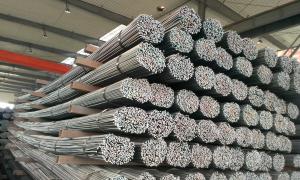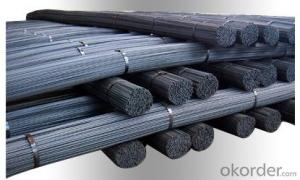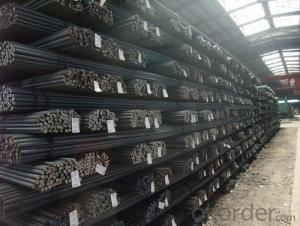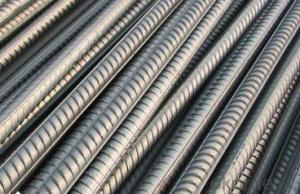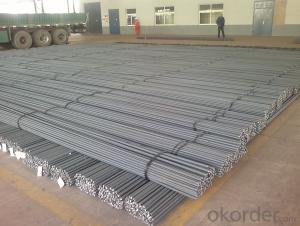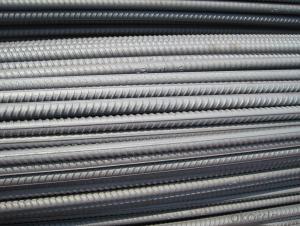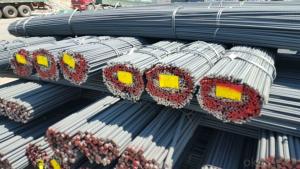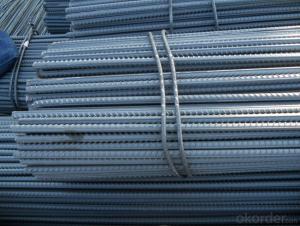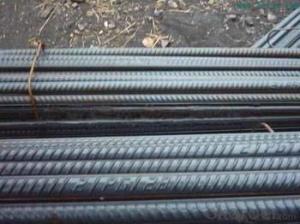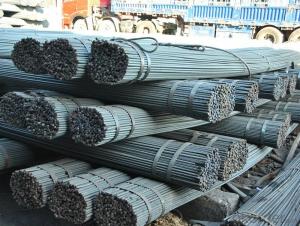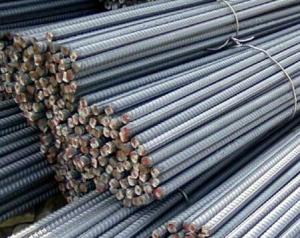Cold Rolled Deformed Bar CRB550
- Loading Port:
- China Main Port
- Payment Terms:
- TT OR LC
- Min Order Qty:
- -
- Supply Capability:
- -
OKorder Service Pledge
OKorder Financial Service
You Might Also Like
Cold Rolled Techniques
Yield Point: 545-565mpa
Theoretical weight and section area of each diameter as below for your information:
Diameter(mm) | Section area (mm²) | Mass(kg/m) | Weight of 12m (kg) | Pcs/ton |
6 | 28.27 | 0.222 | 2.664 | 375.38 |
8 | 50.27 | 0.395 | 4.74 | 210.97 |
10 | 78.54 | 0.617 | 7.404 | 135.06 |
12 | 113.1 | 0.888 | 10.656 | 93.84 |
14 | 153.9 | 1.21 | 14.52 | 68.87 |
16 | 201.1 | 1.58 | 18.96 | 52.74 |
18 | 254.5 | 2.00 | 24 | 41.67 |
20 | 314.2 | 2.47 | 29.64 | 33.74 |
22 | 380.1 | 2.98 | 35.76 | 27.96 |
25 | 490.9 | 3.85 | 46.2 | 21.65 |
28 | 615.8 | 4.83 | 57.96 | 17.25 |
32 | 804.2 | 6.31 | 75.72 | 13.21 |
36 | 1018 | 7.99 | 98.88 | 10.43 |
40 | 1257 | 9.87 | 118.44 | 8.44 |
50 | 1964 | 15.42 | 185.04 | 5.40 |
- Q: What are steel rebars made of?
- Steel rebars, also known as reinforcement bars, are primarily made of carbon steel. Carbon steel is an alloy of iron and carbon, with other elements such as manganese, silicon, and copper added in small quantities to enhance its properties. The carbon content in steel rebars is typically around 0.2% to 0.3%, which provides the necessary strength and durability required for reinforcing concrete structures. The steel used for rebars undergoes a process called hot rolling, where it is heated to high temperatures and then passed through rollers to form the desired shape and size. This process helps to improve the mechanical properties and structural integrity of the rebars, making them suitable for applications that require added strength and support in concrete construction.
- Q: What are the recommended practices for welding steel rebars?
- The recommended practices for welding steel rebars include ensuring proper surface preparation to remove any contaminants, selecting the appropriate welding process (such as shielded metal arc welding or gas metal arc welding), using the correct electrode or filler material, maintaining the appropriate welding parameters (current, voltage, travel speed), and performing regular inspections to ensure the quality and integrity of the welds. It is also important to follow safety guidelines, such as wearing appropriate protective equipment and working in a well-ventilated area.
- Q: What are the factors that affect the durability of steel rebars in concrete?
- There are several factors that affect the durability of steel rebars in concrete. These include the quality of the steel used, the concrete mix design, the level of exposure to environmental conditions, the presence of moisture and chemicals, and the degree of corrosion protection provided. Other factors such as construction techniques, design considerations, and maintenance practices also play a role in determining the durability of steel rebars in concrete structures.
- Q: What is the typical weight per meter of a steel rebar?
- The typical weight per meter of a steel rebar can vary depending on its size and grade. However, as a general guideline, a standard mild steel rebar with a diameter of 10 millimeters (mm) usually weighs around 0.616 kilograms per meter (kg/m). For larger sizes, such as a 20 mm rebar, the weight per meter can increase to approximately 2.47 kg/m. It is important to note that these values are approximate and may vary slightly depending on the specific manufacturing standards and regional regulations.
- Q: Are there any disadvantages or limitations of using steel rebars?
- Yes, there are some disadvantages and limitations of using steel rebars. Firstly, steel rebars are susceptible to corrosion when exposed to moisture and other corrosive elements, which can lead to structural deterioration over time. Additionally, steel rebars are heavy and require skilled labor and heavy machinery for installation, making the construction process more expensive and time-consuming. Furthermore, steel rebars have a high thermal conductivity, which can result in increased heat transfer, making them less suitable for certain applications. Lastly, steel rebars have a high carbon footprint due to the energy-intensive manufacturing process, contributing to environmental concerns.
- Q: Can steel rebars be used in structures with high levels of carbonation or acid attack?
- No, steel rebars should not be used in structures with high levels of carbonation or acid attack. Steel is susceptible to corrosion in acidic environments, and high carbonation levels can increase the acidity of the surroundings. In such conditions, alternative materials that are resistant to corrosion and acid attack, such as stainless steel or fiber-reinforced polymers, should be considered for structural reinforcement.
- Q: Can steel rebars be used in earthquake-resistant structures?
- Yes, steel rebars can be used in earthquake-resistant structures. Steel rebars provide strength and durability to reinforced concrete structures, making them capable of withstanding the forces and vibrations caused by earthquakes. The use of properly designed and placed steel rebars enhances the structural integrity and overall resistance of buildings against seismic events.
- Q: Can steel rebars be used in historical monument conservation?
- Yes, steel rebars can be used in historical monument conservation. They are commonly used to reinforce and strengthen structures, including historical monuments, to ensure their stability and longevity. However, it is important to carefully consider the specific requirements and limitations of each monument to ensure that the use of steel rebars does not compromise its historical integrity or aesthetic value.
- Q: Can steel rebars be used in precast concrete applications?
- Precast concrete applications can make use of steel rebars. When referring to precast concrete, it means the process of casting concrete elements like walls, slabs, or beams in a controlled environment before transporting them to the construction site for installation. Steel rebars, which are typically made of carbon steel and have ribs on their surface to enhance adhesion to the concrete, are commonly utilized to reinforce precast concrete elements. The utilization of steel rebars in precast concrete applications comes with several advantages. Firstly, the presence of rebars increases the overall strength and durability of the precast concrete elements, enabling them to handle higher loads and reducing the risk of structural failure. Additionally, rebars enhance the resistance of precast elements to cracking and shrinkage, thereby ensuring better long-term performance. Furthermore, steel rebars facilitate the efficient transfer of tensile forces within precast concrete elements. While concrete exhibits excellent compressive strength, it is relatively weak in tension. By incorporating rebars into precast elements, the tensile forces generated during service can be effectively absorbed by the rebars, preventing cracks and maintaining the structural integrity of the element. Moreover, steel rebars offer flexibility in design and construction. Precast concrete elements can be manufactured in a wide range of shapes and sizes to meet specific project requirements, and the inclusion of rebars allows for greater design freedom. This enables the creation of complex and intricate precast elements that can be customized to suit various architectural and structural designs. In conclusion, steel rebars are crucial components in precast concrete applications. Their inclusion significantly enhances the strength, durability, and performance of precast concrete elements. By resisting tensile forces and providing structural integrity, steel rebars play a vital role in ensuring the safety and longevity of precast concrete structures.
- Q: How do steel rebars affect the overall load-bearing capacity of a structure?
- The load-bearing capacity of a structure is greatly enhanced by steel rebars. These reinforcing bars are commonly added to concrete structures, such as beams, columns, and slabs, to add strength and durability. The main purpose of rebars is to resist tensile forces, which concrete alone cannot effectively handle. By embedding steel rebars in the concrete, the structure's overall load-bearing capacity significantly increases. When the structure is subjected to a load, the rebars evenly distribute the forces, preventing cracks and reducing the risk of structural failure. This reinforcement improves the structure's ability to withstand heavy loads, including the weight of the building, furniture, occupants, and external forces like wind and earthquakes. Additionally, rebars help control and limit the spread of cracks within the concrete. Concrete is strong in compression but weak in tension, so without rebars, it would easily crack under tensile stress. The rebars act as a reinforcement, absorbing some of the tensile forces and preventing the cracks from expanding, thus maintaining the overall strength of the structure. Furthermore, steel rebars enhance the ductility of the structure. Ductility refers to a material's ability to deform without breaking. When a structure experiences excessive loads or external factors cause deformation, the rebars absorb and dissipate the energy, allowing the structure to deform in a controlled manner instead of collapsing suddenly. To sum up, steel rebars significantly improve the load-bearing capacity of a structure by providing tensile strength, preventing crack propagation, and enhancing ductility. By reinforcing the concrete, rebars ensure that the structure can withstand heavy loads, increasing its strength, durability, and overall safety.
Send your message to us
Cold Rolled Deformed Bar CRB550
- Loading Port:
- China Main Port
- Payment Terms:
- TT OR LC
- Min Order Qty:
- -
- Supply Capability:
- -
OKorder Service Pledge
OKorder Financial Service
Similar products
Hot products
Hot Searches
Related keywords
